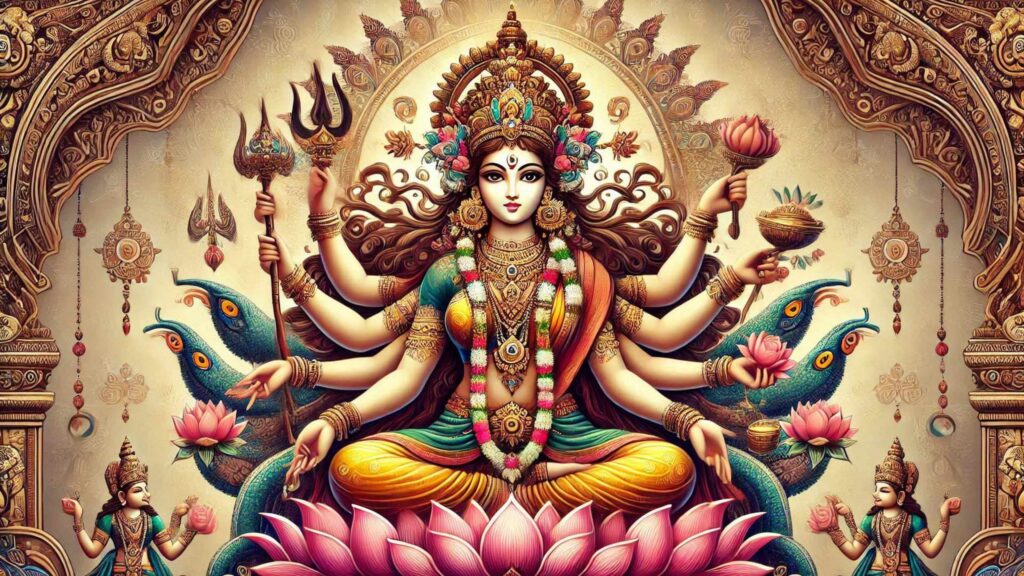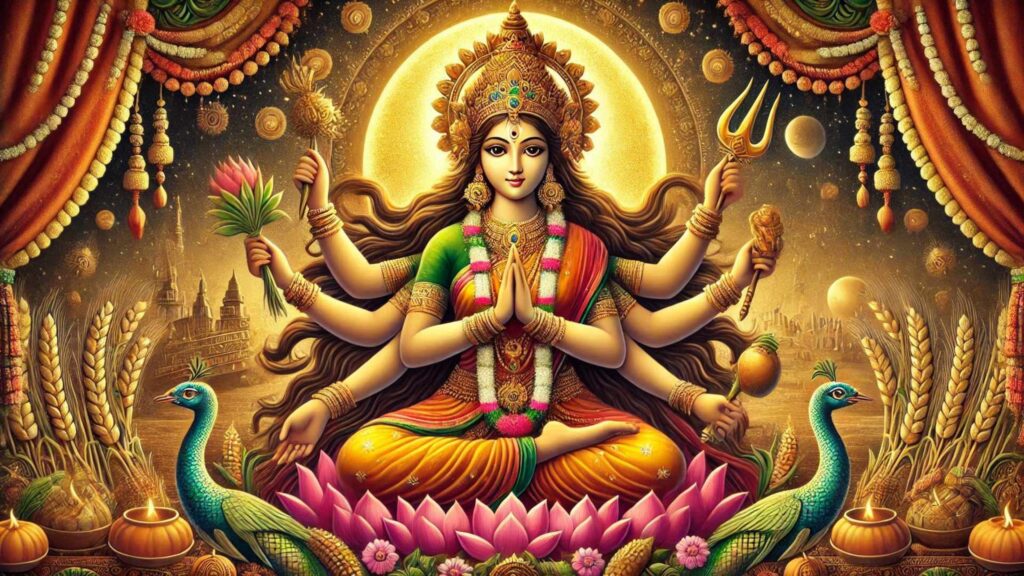Mhalsa: The Divine Consort of Khandoba and Epitome of Devotion in Hinduism
Introduction
A Brief Overview of Mhalsa in Hinduism
Mhalsa is a revered goddess in Hinduism, primarily worshipped as the consort of Lord Khandoba, a form of Lord Shiva. Known for her unwavering devotion and nurturing qualities, Mhalsa symbolizes prosperity, marital harmony, and spiritual strength. Her worship is deeply rooted in the folk traditions of Maharashtra and Karnataka, where she holds a prominent place in rural and temple rituals.
Read More About Deities And Gods
Significance in Daily Hindu Life
Mhalsa represents an ideal blend of strength, devotion, and grace, making her an aspirational figure for devotees. Women, in particular, seek her blessings for marital harmony, prosperity, and spiritual fulfillment. Her story also highlights the balance between worldly duties and spiritual aspirations.
Cosmic and Spiritual Importance
As a divine manifestation of Goddess Parvati, Mhalsa embodies cosmic energy (Shakti). She plays a crucial role in complementing Khandoba’s role as a protector and guide, emphasizing the interconnectedness of feminine and masculine energies in maintaining universal harmony.
Names and Etymology

Meaning of Mhalsa
The name “Mhalsa” is derived from regional vernaculars and is associated with devotion and purity. She is often equated with Goddess Parvati, reflecting her divine origins and nurturing qualities.
Other Names and Their Significance
- Parvati: Highlighting her identity as an incarnation of Shiva’s consort.
- Shivangi: Denoting her inseparable connection with Lord Shiva.
- Khandobachi Bhavani: Revered as Khandoba’s beloved consort, embodying love and devotion.
Symbolism and Iconography

Physical Description and Meaning
Mhalsa is traditionally depicted as:
- A radiant goddess adorned with rich jewelry and a serene expression.
- Holding a pot or offering plate, symbolizing prosperity and nourishment.
- Standing beside Khandoba, emphasizing her role as his equal and partner in spiritual and worldly endeavors.
Symbolism
- Jewelry and Attire: Represent wealth, abundance, and marital bliss.
- Her Calm Demeanor: Reflects balance, devotion, and grace.
- Standing Posture: Indicates readiness to support and nurture the world.
The Flower Connection
The marigold is sacred to Mhalsa and is often used in her worship, symbolizing devotion, brightness, and celebration.
Colors and Symbols
- Yellow and Red: Denote prosperity, energy, and devotion.
- The Cow: Often associated with Mhalsa, symbolizing nurturing and maternal care.
Mythology and Stories

Birth Story
Mhalsa is believed to be an incarnation of Mohini, the enchanting female form of Vishnu, or Parvati, Shiva’s eternal consort. In the legend of Khandoba, she is born as the daughter of a wealthy merchant in Jejuri and later marries Khandoba after he triumphs over demons.
The Story of Mhalsa and Khandoba
Mhalsa’s marriage to Khandoba is central to her mythology. She represents the worldly and marital aspect of Khandoba’s divine duties, balancing his spiritual and protective roles. Her steadfast devotion and partnership are celebrated during numerous folk festivals.
Connection with Other Gods
- Parvati: As an incarnation of Parvati, Mhalsa reflects divine feminine power.
- Khandoba: She complements his role as a guardian deity.
Role in Epics
Mhalsa does not have a direct role in the Ramayana or Mahabharata but is deeply woven into local lore and the oral traditions of Maharashtra and Karnataka.
Famous Blessings and Boons
Devotees believe Mhalsa grants:
- Marital harmony and prosperity.
- Protection from misfortune.
- Spiritual strength and clarity.
Spiritual Significance
A Visible Form of God
Mhalsa serves as a visible and approachable form of the divine, making spiritual concepts accessible to rural communities.
Representation of Knowledge and Enlightenment
Mhalsa represents practical wisdom, balancing worldly responsibilities with spiritual pursuits.
Connection to Spiritual Awakening
Her devotion to Khandoba symbolizes the soul’s journey toward divine unity, inspiring seekers to cultivate discipline and love.
Role in Yoga and Meditation
Mhalsa encourages grounding practices, focusing on inner stability and nurturing energy.
Worship and Rituals
Benefits of Worship
Worshiping Mhalsa is believed to:
- Foster familial and marital harmony.
- Bestow material and spiritual abundance.
- Enhance devotion and emotional resilience.
Daily Worship Practices
- Offering marigold flowers, turmeric, and rice.
- Reciting Mhalsa mantras such as: “Om Mhalsayai Namah”.
- Lighting oil lamps during dawn and dusk prayers.
Best Times for Worship
- Fridays: Associated with feminine energy and prosperity.
- Margashirsha month: Celebrated for auspicious rituals dedicated to Khandoba and Mhalsa.
Important Festivals
- Champashashti: Commemorating Khandoba’s victory over demons and his union with Mhalsa.
- Navratri: Honoring the divine feminine energy in all forms, including Mhalsa.
List of Famous Temples
- Khandoba Temple (Jejuri, Maharashtra): The primary center of Mhalsa worship.
- Mhalsa Narayani Temple (Mardol, Goa): A famous shrine showcasing her cultural significance.
- Shree Martanda Bhairava Temple (Karnataka): A site reflecting her divine connection with Khandoba.
Modern Relevance
Scientific Understanding
- Mhalsa’s narratives inspire holistic living, emphasizing harmony in relationships and personal growth.
- Rituals involving marigolds and turmeric highlight their symbolic and antimicrobial properties.
Environmental Consciousness
The worship of Mhalsa encourages sustainable practices, such as using eco-friendly materials in rituals.
Health Benefits and Energy Connection
- Devotional practices involving Mhalsa enhance mental clarity and emotional stability.
- Ritual fasting during her festivals promotes detoxification and spiritual focus.
Sustainable Living Practices
Mhalsa’s lore advocates balance and respect for nature, inspiring sustainable practices in daily life.
Cultural Impact
Influence on Indian Art and Architecture
Mhalsa’s temples, with intricate carvings and vibrant depictions, reflect her role in folk traditions and spiritual practices.
Presence in Literature and Poetry
Mhalsa is celebrated in folk songs, bhajans, and devotional poetry that glorify her virtues and her partnership with Khandoba.
Impact on Daily Customs
Her influence is seen in marriage rituals and household prayers, where her blessings are sought for prosperity and harmony.
Regional Variations in Worship
- Maharashtra: Focus on her marital role and partnership with Khandoba.
- Goa and Karnataka: Celebrated for her nurturing and protective qualities.
Practical Applications
Morning Prayers and Rituals
Start the day with prayers to Mhalsa to invoke clarity and balance in personal and professional life.
Dietary Recommendations
- Vegetarian offerings during her festivals symbolize purity and simplicity.
- Ritual fasting promotes mindfulness and spiritual focus.
Astrological Significance
Mhalsa is associated with Venus (Shukra), representing love, prosperity, and creativity.
Gemstones and Metals
- Gold: Reflecting prosperity and divine energy.
- Turquoise: Enhancing harmony and emotional balance.
Conclusion
Summary
Mhalsa embodies devotion, grace, and prosperity. As the consort of Khandoba, she inspires balance between worldly responsibilities and spiritual aspirations, making her an integral part of Hindu worship and folk traditions.
Universal Message
Mhalsa’s story teaches the value of devotion, partnership, and inner strength in overcoming challenges and achieving fulfillment.
Call to Action
Embrace Mhalsa’s teachings to nurture balance, foster harmony in relationships, and pursue spiritual and material abundance.


